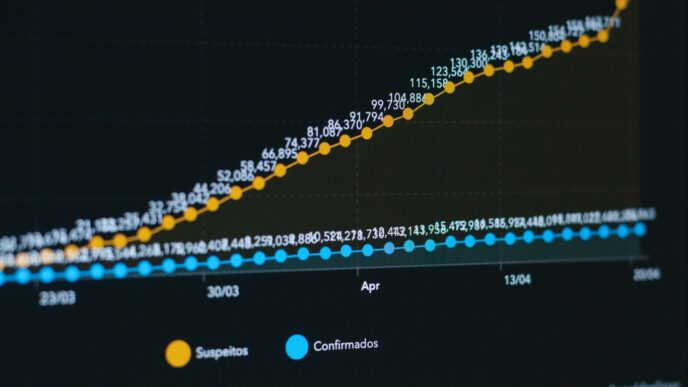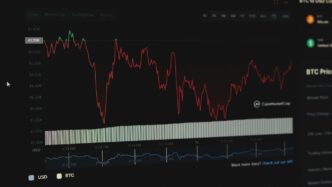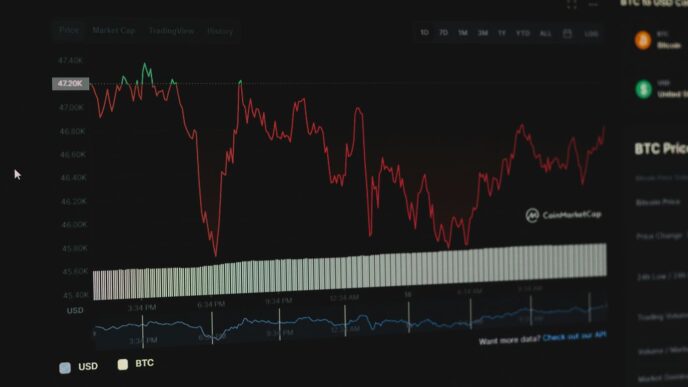So, you’re probably hearing a lot about layoffs lately, right? It seems like every other day there’s news about another company letting people go. It makes you wonder, how do we keep track of all this? And more importantly, how can we get a heads-up before it happens? That’s where something called the WARN database comes in. It’s not perfect, but it’s a pretty useful tool for understanding what’s going on in the job market, especially when things feel a bit shaky. We’re going to take a closer look at this WARN database and see how it works, what it tells us, and how it might help us make sense of all these changes.
Key Takeaways
- The WARN Act requires certain employers to give advance notice of mass layoffs, acting as an early signal for job market changes.
- Even though WARN notices cover only a small part of all layoffs, they can predict bigger layoff trends.
- Getting a heads-up through a WARN notice might give workers a little more time to find new jobs, but it’s not a magic fix for job loss.
- The rules for WARN notices can change from state to state, which affects how we collect and understand the data.
- You can get information from the WARN database to see layoff patterns by state, company, or even specific job types.
The WARN Database: An Early Warning System
The WARN (Worker Adjustment and Retraining Notification) Act and the resulting WARN database serve as a critical tool for understanding and anticipating shifts in the labor market. It’s like a heads-up display for the economy, giving us a peek at potential trouble spots before they fully materialize. Let’s take a closer look at how this system works.
Understanding the WARN Act Mandate
The WARN Act is all about providing workers and communities with advance notice of major layoffs or plant closings. Basically, companies with 100 or more employees are required to give at least 60 calendar days’ notice before a mass layoff affecting 50 or more employees at a single site of employment, or a plant closing affecting 50 or more employees. This notice is intended to give affected workers time to prepare for job loss and seek new employment. The idea is to soften the blow of sudden unemployment, giving people a chance to get their ducks in a row. It’s not a perfect system, but it’s a step in the right direction. You can track workforce reductions using the WARN database.
WARN Notices as Leading Indicators
WARN notices aren’t just about compliance; they can also act as leading indicators of economic change. When a company files a WARN notice, it suggests that they’re anticipating a downturn in business or undergoing restructuring. By tracking the number and size of these notices, economists and policymakers can get a sense of where the economy might be headed. It’s like watching the canary in the coal mine – an early sign of potential problems. Of course, it’s not a foolproof predictor, but it’s another piece of data to consider. For example, a spike in WARN notices in a particular industry might signal broader issues within that sector.
Comparing WARN Data to JOLTS
To get a more complete picture of the labor market, it’s helpful to compare WARN data to other sources, such as the Job Openings and Labor Turnover Survey (JOLTS). While WARN data focuses on job losses, JOLTS provides insights into job openings, hires, and separations. By looking at both datasets, we can get a better understanding of the overall health of the labor market. For instance, if WARN notices are increasing while job openings are decreasing, it could be a sign of a weakening economy. Conversely, if WARN notices are low and job openings are high, it could indicate a strong labor market. It’s all about putting the pieces together to see the bigger picture.
Impact of Advance Notice on Re-Employment

Correlation Between Notice Period and Job Security
Does getting a heads-up before a layoff actually help? That’s the big question. The idea behind the WARN Act is that more notice equals more time to find a new job. It sounds simple, but the reality is a bit more complex. Think of it like this: if you know a storm is coming, you have time to prepare. Same with job loss.
- More time to update your resume.
- More time to network.
- More time to mentally prepare.
But how much does it really matter? Some studies suggest a positive link between the length of the notice period and how quickly people find new work. The longer the notice, the better the chances, at least in theory. But it’s not a magic bullet. The job market itself plays a huge role. If there aren’t many jobs available, even a long notice period might not be enough.
Factors Influencing Re-Employment Outcomes
It’s not just about the notice period. Lots of things affect how quickly someone finds a new job after a layoff. Skills, industry, location – they all matter. Someone with in-demand tech skills might bounce back quickly, while someone in a shrinking industry might have a tougher time. The overall economy is a huge factor too. A strong economy means more job openings, making it easier for people to find work. Also, consider the type of job. Was it a specialized role, or something more common? Specialized roles might take longer to replace. And let’s not forget personal factors like motivation and access to resources. Some people are naturally better at job searching than others. Accessing public WARN records can help understand these trends.
Here’s a quick rundown of factors:
- Skills and Experience: Are your skills in demand?
- Industry Trends: Is the industry growing or shrinking?
- Economic Conditions: Is the economy strong or weak?
- Location: Are there jobs available in your area?
Limitations of Advance Layoff Notices
Okay, so advance notice can help, but it’s not a perfect solution. One big problem is that the WARN Act has loopholes. Companies can sometimes get away with giving less than 60 days’ notice if they claim the layoff was due to unforeseen circumstances. Also, the WARN Act doesn’t cover all companies or all layoffs. Small businesses and layoffs affecting fewer than 50 people might not be included. Plus, even with notice, the emotional impact of a layoff can be tough to deal with. It can affect your confidence and make it harder to focus on job searching. And let’s be honest, knowing you’re going to lose your job can be stressful, even if you have time to prepare. The effectiveness of state WARN requirements varies.
Here are some limitations to keep in mind:
- Loopholes in the WARN Act: Companies can sometimes avoid giving full notice.
- Limited Coverage: Not all companies or layoffs are covered.
- Emotional Impact: Job loss is stressful, even with notice.
Navigating Layoffs: The Role of the WARN Database
The WARN (Worker Adjustment and Retraining Notification) database is more than just a collection of layoff notices; it’s a tool that can be used to understand and potentially mitigate the impact of job losses. Let’s explore how to use this data effectively.
Accessing Public WARN Records
Finding WARN data isn’t as hard as you might think. Most states that have their own WARN Acts require employers to file these notices publicly. This means you can often find them on state labor department websites. Some third-party sites, like WARNTracker, also compile this information from various sources, making it easier to search and analyze. Keep in mind that the data might not be exhaustive, as not all states mandate full disclosure. The data is collected through direct requests to state government agencies, news sources, and layoff trackers.
Analyzing Layoff Trends by State
One of the most useful things you can do with WARN data is to track layoff trends by state. This can give you a sense of which areas are experiencing economic hardship and which industries are most affected. For example, you might see a spike in layoff charts by state and year in states heavily reliant on manufacturing or technology during certain economic downturns. This information can be valuable for job seekers, policymakers, and businesses alike.
Utilizing WARN Data for Economic Insights
WARN notices can act as leading indicators of broader economic shifts. Because companies are required to provide advance notice of mass layoffs, these notices can signal potential economic trouble ahead. Economists and analysts can use this data to identify emerging trends, assess the health of different sectors, and inform policy decisions. It’s like getting an early warning about potential storms on the horizon. The effectiveness of WARN notices may depend on additional factors, such as the state of the local labor market, industry-specific dynamics, and the availability of job-matching services or retraining programs. WARN protections should be coupled with broader workforce development initiatives to improve outcomes for laid off workers.
State-Specific WARN Act Variations
The federal WARN Act sets a baseline, but many states have gone further, creating a patchwork of regulations that employers need to understand. It’s not a one-size-fits-all situation, and failing to comply with state-specific rules can lead to significant penalties. Let’s take a look at some of the key differences.
Federal Versus State WARN Requirements
The federal WARN Act generally applies to employers with 100 or more full-time employees, requiring 60 days’ notice before a mass layoff affecting at least 50 employees. However, several states have enacted their own versions of the WARN Act, often with stricter provisions. These state laws can differ significantly from the federal standard in terms of coverage, notice periods, and severance requirements. For example, some states may apply the WARN Act to smaller employers or require longer notice periods. Understanding these nuances is important for businesses operating in multiple states. It’s not just about ticking a box; it’s about understanding the local labor landscape. For example, California employment lawyers can help you navigate the complexities of state-specific regulations.
Impact of State Regulations on Layoff Data
State-level variations in WARN Acts directly impact the data collected and reported. States with stricter requirements may report more layoff events, even if the actual number of affected employees is similar to states with less stringent regulations. This is because the threshold for triggering a WARN notice can be lower in some states. For instance, a state might require notice for layoffs affecting just 25 employees, while the federal threshold is 50. This difference in reporting thresholds can skew the overall picture of layoff trends if not properly accounted for. It’s important to consider these differences when analyzing layoff trends across different states.
Data Collection Methodologies for the WARN Database
The way states collect and report WARN data can also vary. Some states have centralized online databases that are easily accessible to the public, while others rely on manual reporting processes. This can lead to inconsistencies in data quality and completeness. For example, some states may only report layoffs that meet the federal threshold, while others include layoffs that meet their own, stricter state-level thresholds. Additionally, the level of detail provided in WARN notices can vary, with some states requiring more information about the affected employees and the reasons for the layoff. These differences in data collection methodologies can make it challenging to compare layoff trends across states and highlight the need for purchasing historical WARN data to ensure accuracy.
The WARN Database in a Sluggish Labor Market
WARN Notices and Macroeconomic Shifts
WARN notices can be a pretty useful tool for understanding what’s happening in the broader economy. They often pop up right before big changes in the market. Because companies have to file these notices in advance, they give economists and policymakers a heads-up about potential problems. Think of it as an early warning system that complements other economic data, helping to paint a clearer picture of the labor market’s health. For example, if we see a spike in compensation software market WARN filings, it might signal upcoming economic challenges.
Effectiveness of WARN in Current Conditions
In today’s slow labor market, where hiring isn’t as robust as it used to be, the impact of WARN notices is something to consider. While longer notice periods can help people find new jobs a bit faster, it’s not a complete fix. The effectiveness of WARN depends on things like the local job market, what industry you’re in, and if there are job-matching or retraining programs available. It’s like giving someone a map, but they still need a car and gas to get where they’re going. WARN works best when it’s paired with other efforts to help workers get back on their feet. From 2018 to 2024, the percentage of WARN notices filed 60 or more days in advance increased, except for 2020, when the pandemic caused many businesses to be unable to comply with the standard notice requirements.
Integrating WARN with Workforce Development
So, how can we make WARN even better? Maybe it’s time to think about updating the rules to fit today’s workforce. This could mean including smaller businesses or part-time workers, or even adding stronger ways to enforce the rules. With more people working remotely or doing gig work, it’s also getting trickier to define what a layoff even is. The WARN Act serves as a signal of broader labor market trends. Here are some ways to integrate WARN data with workforce development:
- Early Intervention Programs: Use WARN data to proactively offer job search assistance, retraining programs, and financial counseling to affected workers.
- Targeted Industry Support: Identify industries experiencing frequent layoffs and provide specialized support to help workers transition to growing sectors.
- Community Resource Coordination: Connect laid-off workers with local resources, such as unemployment benefits, housing assistance, and mental health services.
Acquiring and Utilizing WARN Database Information
The WARN database is a pretty useful tool, but figuring out how to actually get the data and then use it can be a bit tricky. Let’s break down some ways to get your hands on this info and what you can do with it once you have it.
Purchasing Historical WARN Data
Sometimes, you need to look back to understand what’s happening now. Purchasing historical WARN data can give you a broader view of layoff trends over time. This is especially helpful if you’re trying to spot long-term patterns or compare different economic periods. You can often find this data through specialized data providers or even directly from some state labor departments. The cost will vary depending on the scope and detail of the data you need.
Subscribing to Future WARN Notices
Staying up-to-date is key. Subscribing to future WARN notices is like getting a heads-up on potential economic shifts in real-time. Several services offer email alerts or data feeds that notify you whenever a new WARN notice is filed in your area or industry. This can be super useful for job seekers, investors, or anyone tracking the labor market. Some things to consider:
- Coverage: Does the service cover all the states you’re interested in?
- Frequency: How often are the notices updated?
- Cost: What’s the subscription fee, and is it worth it for the information you’re getting?
Requesting Company-Specific Layoff Details
Want to know what’s happening with a specific company? You can try requesting company-specific layoff details. This might involve contacting the state labor department directly or using public records requests. Keep in mind that not all information may be readily available, and there might be some red tape involved. But if you’re doing research on a particular employer, it can be worth the effort. You can access public WARN records to find company-specific information.
Insights from the WARN Database
The WARN database is more than just a list of layoffs; it’s a window into the economic health of different regions and industries. By carefully analyzing the data, we can uncover trends and patterns that might otherwise go unnoticed. It’s like having a special tool to see what’s coming next in the job market. Let’s take a look at some of the ways we can use this data to gain valuable insights.
Layoff Charts by State and Year
One of the most straightforward ways to use the WARN database is to create layoff charts that show the number of layoffs in each state over time. This allows us to quickly identify which states are experiencing the most significant job losses and whether those losses are increasing or decreasing. These charts can reveal regional economic struggles or booms.
For example, a chart might show that California had a spike in layoffs in 2023, while Texas remained relatively stable. This could indicate that certain industries are struggling in California, or that companies are moving jobs to Texas. Here’s a simplified example of what such a chart might look like:
| State | 2023 Layoffs | 2024 Layoffs (YTD) |
|---|---|---|
| California | 15,000 | 8,000 |
| Texas | 5,000 | 3,000 |
| New York | 7,000 | 4,000 |
Analyzing Layoffs by Company and Role
Beyond state-level data, the WARN database lets us zoom in on specific companies and the types of roles being affected by layoffs. This can be really useful for job seekers who want to know which companies are downsizing and which skills are becoming less in demand. It also helps us understand which sectors are most vulnerable. For example, we might find that a particular tech company has announced multiple rounds of layoffs, primarily affecting software engineers. This could signal a slowdown in that specific area of the tech industry. You can even track industry-specific layoff trends to get a better idea of the overall market.
Tracking Industry-Specific Layoff Trends
By grouping layoff notices by industry, we can identify broader trends affecting entire sectors of the economy. Are manufacturing jobs declining? Is the retail sector struggling? The WARN database can provide answers. This information is valuable for investors, policymakers, and anyone interested in understanding the changing landscape of the job market. For instance, if we see a consistent increase in layoff notices from the retail industry, it could be a sign of changing consumer habits or increased competition from online retailers. This is a great way to access public WARN records and make informed decisions.
Here are some potential industry trends you might observe:
- Technology: Layoffs in software development and hardware manufacturing.
- Manufacturing: Declines in automotive and industrial equipment sectors.
- Retail: Job losses due to store closures and shifts to e-commerce.
- Finance: Reductions in banking and investment firms due to automation or market volatility.
Wrapping Things Up
So, what’s the big takeaway here? The WARN database, even though it only covers a piece of all layoffs, is pretty useful. It gives us an early heads-up about what’s happening in the job market, way before other reports come out. We saw that getting more notice before a layoff can help people find new jobs a little faster. But let’s be real, it’s not a magic fix, especially when the job market is slow. The WARN Act is a good start, but it works best when it’s part of bigger plans to help workers. It’s a signal, not the whole story, and it reminds us that supporting people through job changes is a team effort.
Frequently Asked Questions
Where does this data come from?
This information comes from public records that companies have to share with certain states when they have big layoffs.
What is WARN?
WARN stands for Worker Adjustment and Retraining Notification. It’s a rule in the U.S. that says companies with 100 or more full-time workers must give at least 60 days’ notice before closing a factory or having a large layoff that affects 50 or more people. This notice helps employees get ready for job changes. The exact rules can be a bit different in each state, but the main idea is to give workers a heads-up about losing their jobs.
Is this data complete?
No, it’s not everything. Not every state has a WARN Act that makes companies share all their layoff details. So, this data doesn’t cover every single layoff that happens.
How was this data collected?
We gather our WARN data in a few ways: by asking state government offices directly for their records, checking news stories, and comparing our findings with other layoff trackers.
How can I get the full data?
You can find a small part of our WARN layoff data from 2024 below. If you want to see all of it, please click here.
How can I get in touch or suggest new things?
Please use this form if you have any questions, want to ask for specific layoff data, or have ideas for new features. We’d love to hear from you!














